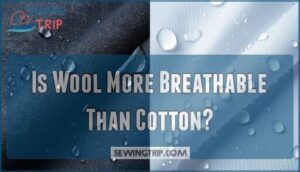This site is supported by our readers. We may earn a commission, at no cost to you, if you purchase through links.

These spaces allow air to circulate while moisture vapor escapes from your skin, preventing that sticky feeling you get with synthetic materials.
Wool’s superpower lies in absorbing up to 30% of its weight in moisture while still feeling dry to the touch.
It wicks sweat away from your body and releases it through evaporation, keeping you comfortable whether you’re sweating or cooling down.
This natural ventilation system adapts to your body’s needs in real-time.
But there’s more to wool’s breathability story than just fiber structure.
Table Of Contents
- Key Takeaways
- Is Wool Breathable?
- How Does Wool Provide Effective Moisture and Temperature Management?
- What is The Natural Crimp of Wool and How Does It Provide Superior Insulation?
- Does Wool Reduce Post-Exercise Chill?
- Can Wool Keep You Cooler in Hot, Dry Environments?
- Does Wool Have Odor-Resistant Properties?
- Why is Merino Wool Considered Breathable?
- Is Mineral Wool Breathable?
- Is Wool More Breathable Than Cotton?
- Can Wool Be Worn Comfortably in The Summer?
- Frequently Asked Questions (FAQs)
- Conclusion
Key Takeaways
- You’ll stay dry even when sweating – wool absorbs up to 30% of its weight in moisture while still feeling dry to the touch, then releases it through evaporation
- Wool’s crimped fibers create natural air conditioning – the spiral structure forms microscopic air pockets that trap warm air when it is cold and allow heat to escape when you’re active
- It outperforms cotton and synthetics for moisture management – wool transfers 25% more moisture than cotton and doesn’t trap heat like synthetic materials do
- You can wear it year-round comfortably – lightweight wool varieties work well in summer by regulating temperature, while heavier weights provide insulation in cold weather
Is Wool Breathable?
Wool is naturally breathable thanks to its unique fiber structure and natural crimp.
The fiber diameter impact varies—finer wool like merino creates better breathability through tiny air pockets between fibers.
Wool weave density affects airflow too; looser weaves enhance fabric breathability while tighter ones reduce it.
Unlike synthetic blend effects that trap heat, pure wool properties allow moisture wicking and temperature regulation.
Your wool activity level matters—wool excels during movement by managing sweat effectively.
This breathability vs. warmth balance makes wool ideal for varying conditions, outperforming many breathable fabrics.
The natural fibers of wool also exhibit excellent cashmere breathability properties, making it a great choice for clothing with temperature regulation.
How Does Wool Provide Effective Moisture and Temperature Management?
Your body’s natural cooling system works best when wool helps manage moisture and temperature regulation.
The secret lies in wool’s unique fiber structure, which absorbs up to 30% of its weight in moisture without feeling damp, then releases heat during evaporation.
Here’s how wool provides effective moisture control:
- Moisture wicking: Wool fibers pull sweat away from your skin 25% more effectively than synthetic materials
- Natural cooling: The evaporation process creates a cooling effect that regulates body temperature
- Breathable fabrics: Wool’s structure allows air circulation while maintaining insulation properties
This dual-action system means you’ll stay comfortable during exercise and avoid post-workout chills.
Whether you’re hiking in humidity or working in heat, wool insulation adapts to your body’s needs through superior temperature regulation.
What is The Natural Crimp of Wool and How Does It Provide Superior Insulation?
Natural forces shape wool in ways that synthetic materials can’t replicate. Wool Crimp creates the foundation for wool’s remarkable Insulation Properties through its unique Fiber Structure. Each wool fiber naturally spirals in a helical pattern, averaging 2-12 crimps per centimeter depending on the sheep breed.
These Crimped Fibers form microscopic air pockets that trap warm air close to your skin, creating Natural Thermal barriers. Merino wool showcases up to 100 crimps per inch, explaining why it feels so comfortable against your skin. This 3D structure makes wool bulkier than flat fibers, enhancing loft and warmth retention.
The crimped design provides multiple benefits:
- Air pockets trap heat while allowing moisture regulation and temperature regulation
- Resilient spring-like structure maintains shape and reduces wrinkling after wear
- Superior warmth retention even when compressed under clothing layers
Wool breathability stems from this same crimp structure – natural fibers with built-in ventilation systems that outperform cotton and synthetic alternatives by 10-15% in heat retention studies.
Does Wool Reduce Post-Exercise Chill?
After intense workouts, you’re left feeling cold and clammy – but wool clothing changes this experience completely. Post workout comfort becomes achievable when you choose breathable fabrics that actively manage moisture regulation.
Merino wool’s unique fiber structure creates effective chill prevention through its superior thermal regulation properties. The crimped fibers form tiny air pockets that provide wool insulation while simultaneously wicking sweat away from your skin.
This dual action prevents the dreaded post-exercise shiver that happens when wet clothing meets cooling skin. Unlike synthetic materials that trap moisture, wool breathability allows perspiration to evaporate quickly.
Your body temperature stays stable as the fabric releases excess heat during activity, then provides warmth as you cool down. This natural temperature regulation makes wool ideal for exercise recovery periods.
Smart athletes choose merino wool base layers specifically for this reason – they eliminate uncomfortable chills while maintaining peak comfort throughout their entire workout routine.
Can Wool Keep You Cooler in Hot, Dry Environments?
Contrary to popular belief, wool cooling works exceptionally well in scorching desert conditions.
Wool’s unique fiber structure creates natural air pockets that facilitate breathable fabrics and heat regulation. When you sweat, wool’s moisture-wicking properties absorb up to 35% of the fabric’s weight while staying dry to touch.
Desert dwellers have trusted wool for centuries—it naturally cools you when temperatures soar.
Here’s how wool maintains thermal balance in hot climates:
- Evaporative cooling – Wool releases absorbed moisture as vapor, creating a natural air conditioning effect that keeps skin temperatures up to 2°C cooler than synthetics
- UV protection – Natural fibers provide UPF ratings of 30-50+, blocking harmful radiation while maintaining dry comfort
- Superior airflow – Wool’s crimped structure promotes ventilation better than cotton, preventing that sticky feeling during summer wear
Desert populations like Bedouins have relied on wool for centuries because it doesn’t trap heat like synthetic materials. Temperature regulation through wool breathability makes it surprisingly effective for staying cool when mercury rises.
Does Wool Have Odor-Resistant Properties?
Wool fights odors better than you’d expect. Its unique fiber structure absorbs moisture up to 35% of its weight, creating an environment where odor-causing bacteria struggle to multiply. The high sulfur proteins in wool bind and lock odor molecules within the fiber core, keeping them trapped until washing.
Studies show wool retains 66% less body odor than polyester and 28% less than cotton after wear. This anti microbial action isn’t from killing bacteria – it’s from wool’s ability to remove bacteria when you take the garment off.
Wool’s natural moisture management properties contribute to its effectiveness in controlling odor.
| Fabric Type | Odor Retention After Use |
|---|---|
| Polyester | High (requires frequent washing) |
| Cotton | Moderate (needs regular cleaning) |
| Wool Blends (20%) | Low (nearly matches 100% wool) |
| 100% Wool | Lowest (wear more, wash less) |
| Treated Wool | Enhanced resistance (lab-proven) |
This natural deodorizing means your breathable wool clothing stays fresh longer. Moisture-wicking properties and scent resistance make wool perfect for multi-day wear, especially during travel or outdoor activities where frequent laundering isn’t possible.
Why is Merino Wool Considered Breathable?
Merino wool stands out for its exceptional breathability thanks to its unique fiber structure and natural properties.
Merino wool’s crimped fibers create natural air pockets that let your skin breathe while managing moisture effortlessly.
You’ll find that fine merino fibers create microscopic air pockets that allow heat and moisture to escape while maintaining comfort across different temperatures, which is a key aspect of its exceptional comfort.
Merino Wool’s Air Pockets
Merino wool’s natural crimp creates microscopic air pockets throughout the fiber structure, forming a breathability mechanics system that’s hard to beat.
These tiny spaces trap warm air during cold weather while allowing moisture-wicking and thermal regulation when you’re active.
The air pocket formation lets vapor escape efficiently, preventing that clammy feeling you’d get with synthetic materials.
This fiber structure gives Merino wool its superior moisture absorption capabilities. The unique properties of merino wool provide excellent temperature regulation benefits that enhance its overall performance.
Fine Fibers Increase Breathability
Beyond air pockets, fiber thickness plays a pivotal role in breathability.
Merino wool fibers measure under 20 microns in diameter—substantially finer than traditional wool.
These fine fibers create more surface area for air movement and enhanced moisture wicking.
The smaller diameter allows fibers to bend easily, reducing irritation while creating additional air-trapping spaces that improve natural insulation and knitwear breathability.
The use of merino wool products is essential for superior performance in various activities.
Alpaca Wool’s Breathability
Alpaca fiber offers impressive breathability that rivals merino wool.
You’ll find alpaca wool’s semi-hollow structure creates exceptional air circulation and moisture management. The fiber’s unique thermal regulation properties keep you comfortable across seasons.
Here’s what makes alpaca wool breathable:
- Semi-hollow fibers create natural air pockets for superior ventilation
- 11% moisture absorption before feeling damp, with faster drying than merino
- Excellent insulation when wet, maintaining comfort against skin
- Natural fiber structure promotes airflow and prevents overheating
- Temperature adaptability works well in both warm and cool conditions
Is Mineral Wool Breathable?
Mineral wool excels as thermal insulation but differs from natural wool fibers used in clothing.
This breathable material allows natural ventilation through its 98% porous structure, making it highly effective for building applications. The air pockets between fibers create excellent breathability while maintaining superior insulation properties.
However, you shouldn’t confuse mineral wool with wool benefits found in clothing:
- Texture concerns – The coarse fibers can irritate skin, unlike soft natural fibers
- Industrial composition – Contains recycled glass and slag unsuitable for direct skin contact
- Application mismatch – Designed for buildings, not moisture-wicking breathable fabrics
While mineral wool’s breathability works perfectly for construction, natural wool remains your best choice for comfortable, breathable clothing.
Is Wool More Breathable Than Cotton?
Looking at wool comparison tests, natural fibers consistently outperform cotton in breathability.
When you compare fabric weave structures, wool’s crimped fibers create air pockets that enhance moisture-wicking capabilities far beyond cotton’s flat structure.
Cotton analysis shows it absorbs moisture but retains it, while breathable fabric like wool actively moves moisture away from your skin.
Breathability tests reveal wool transfers 25% more moisture than cotton, keeping moisture levels lower against your body, which makes wool benefits clear – you’ll stay drier and more comfortable than in cotton garments during physical activities, due to the superior moisture-wicking capabilities.
Can Wool Be Worn Comfortably in The Summer?
You might wonder if wool’s excellent breathability translates to summer comfort. The answer is yes, with the right approach.
Lightweight merino and other fine wool varieties excel as breathable fabric options during warm weather. Their natural thermal regulation keeps you comfortable without overheating.
Here’s how to wear summer wool successfully:
- Choose lightweight knits – Fine gauge wool fabrics allow maximum airflow
- Opt for loose weaves – Open constructions enhance breathability and cooling
- Select moisture-wicking styles – Garments designed for warmweather activities perform best.
Summer wool comfort depends on fabric weight and construction. Fine wool fibers create air pockets that release heat while absorbing moisture.
This makes wool surprisingly effective for seasonal layering, even in hot conditions. Unlike synthetic materials that trap heat, breathable knits made from quality wool actually help regulate your body temperature.
You’ll stay cooler and drier during summer activities, making wool a smart choice year-round. For ideal performance, consider summer wool clothing options that balance warmth and breathability.
Frequently Asked Questions (FAQs)
Is wool breathable?
Like a perfect thermostat, wool naturally regulates airflow through its fiber structure.
You’ll find it breathes exceptionally well because wool fibers absorb moisture vapor and create air pockets that allow circulation while maintaining comfort, with wool fibers being key to this process and providing natural regulation.
Why is wool fabric breathable?
Wool’s breathable because its natural fibers have a unique structure with microscopic scales and crimp that create air pockets, allowing moisture vapor to pass through.
While the fiber’s ability to absorb and release moisture keeps you comfortable.
Why is wool more breathable than synthetic?
Natural fibers in wool have a unique structure that allows air to flow freely between fibers, while synthetic materials trap heat and moisture due to their dense, non-porous construction.
How do you make wool breathable?
Think of wool fibers as tiny breathing tubes—their natural structure already creates airflow.
You can’t really "make" wool more breathable, but you’ll enhance it by choosing lighter weights, looser weaves, and ensuring proper garment fit for maximum air circulation, which involves considering proper garment fit.
Is nylon more breathable than wool?
No, nylon isn’t more breathable than wool.
Wool absorbs 30% of its weight in moisture without feeling wet, while nylon traps sweat and heat, making you feel clammy and uncomfortable during activities.
Is cotton more breathable than wool?
Cotton isn’t quite the breathability champion you’d expect.
While cotton feels light and airy, wool actually outperforms it in moisture management, wicking away 25% more sweat and keeping you drier through better temperature regulation.
What are the disadvantages of wool?
Wool’s main disadvantages include higher costs, reduced durability with frequent washing, potential shrinkage if improperly cleaned, and possible skin irritation for sensitive individuals despite its softness.
Does wool keep you from sweating?
Like a medieval tapestry weaver’s finest thread, wool doesn’t stop you from sweating but brilliantly manages moisture by absorbing up to 30% of its weight while wicking sweat away from your skin.
How does wool fabric weight affect breathability?
Lighter wool fabrics let you breathe easier since they’re less dense and allow better airflow.
Thicker, heavier wool creates more insulation but restricts air circulation, making you feel warmer and potentially stuffier during active wear, which affects overall airflow.
What weave patterns make wool most breathable?
Open weaves like plain or basket patterns maximize airflow through wool fibers.
You’ll find loose knits and loosely woven fabrics breathe best, creating cooling air pockets while maintaining wool’s natural moisture-wicking properties, and this is due to the airflow.
Conclusion
Forget everything you’ve heard about wool being stuffy or old-fashioned – this natural fiber is basically nature’s air conditioning system.
So, is wool breathable? Absolutely. Its crimped structure creates micro air pockets that circulate air while wicking moisture away from your skin.
You’ll absorb up to 30% of your weight in sweat without feeling damp. Whether you’re hiking mountains or sitting in meetings, wool’s natural ventilation adapts to keep you comfortable year-round, making it a great choice due to its breathable properties.
















